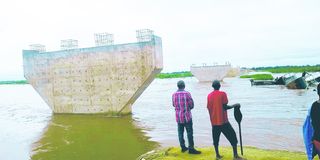Good governance can reduce perception of actual corruption in public projects

Bridge construction at Kilombero in Morogoro is in progress. PHOTO |FILE
What you need to know:
- It is common that a high ranking official or politicians will inspect a project, express dissatisfaction with what is going on and order that the implementers be apprehended, by the police or by the Prevention of Corruption Bureau (PCCB).
- It is rare that complaints will come from the local populations themselves even where they are the direct beneficiaries of the project.
January 17, 2022 was a memorable day for many youngsters in the country since it was school opening day. Millions of these young people reported at their respective schools and found that the government was well-prepared to receive them. For some months before that date, there had been a flurry of activities throughout the country, as authorities worked day and night to put up quality class room and other building as part of the President’s drive to improve the learning infrastructure in the country.
She had warned that these buildings be in place well before time so that students “do not smell paint”; she had also warned that the works must be of high quality reflecting the amount of money that government had dished out.
We are yet to hear of complaints of shoddy works as far as this project of ending the shortage of class rooms in the country is concerned.
But this is not the case with many other projects.
It is common to learn from the media that after an inspection visit to such and such area, the Minister, the Permanent Secretary, the Regional Commissioner, the District Commissioner or other dignitary who made the visit, complained of shoddy work. This could be in terms of poor building materials; poor workmanship; and the quality of the work and the stage of implementation attained not being commensurate with the amount of money used.
Sometimes these adverse observations come from such an unexpected corner, as the leader of the Uhuru Torch Race. By way of example, in August, 2021, the leader of the Uhuru Torch race expressed dismay over the water supply projects being implemented in Mtwara Region branding them as “shoddy and dubious”.
Four years ago, in January 2018, the Prime Minister had expressed dissatisfaction with the construction of the-then recently constructed Customs Centre at Sirari in Mara Region, and had summoned the contractor to his office in Dodoma to explain the short comings.
It is common that a high ranking official or politicians will inspect a project, express dissatisfaction with what is going on and order that the implementers be apprehended, by the police or by the Prevention of Corruption Bureau (PCCB).
Why should identification of short-comings wait till a visit by a high ranking person?
It is rare that complaints will come from the local populations themselves even where they are the direct beneficiaries of the project.
They may not be aware of the design and package involved in the project; the standards expected; the implementation schedule and deadlines; the amount of money involved; and sometimes, they may not know how the contractor and supplies are procured.
To improve the implementation of public projects and enhance efficiency, a good governance approach may be useful and it is highly recommended as way of reducing corruption.
Among the key principles of good governance are: transparency, accountability, rule of law, public participation and decentralisation.
This means public projects must be implemented in a transparent manner, with people knowing what is going on and not just being recipients. People should be able to follow and understand the decision-making process.
This will enable them to see clearly how and why a decision was made– what information, advice and consultation was considered, and which legislative requirements were followed.
The principle of accountability means that officials have a duty to report, explain and be answerable for the consequences of decisions made on behalf of the citizens.
Following the rule of law entails that decisions are in line with relevant legislation and are within the powers of the authorities, and procedures are not circumvented or short-circuited.
Public participation means that all those affected by, or interested in, a decision must have the opportunity to participate in the process for making that decision.
This can be realized in a number of ways such as community members being provided with information, asked for their opinion, given the opportunity to make recommendations or, in some cases, be part of the actual decision-making and implementation process.
The principle of decentralization aims, as far as practicable, to devolve powers of decision making and implementation to as low a level of government as possible.
Implementing public projects with good governance in mind may mean that there are local and representative committees that are part and parcel of the execution process.
That way, it may not need the intervention of a high ranking dignitary to ensure that public projects are implemented efficiently and effectively.




